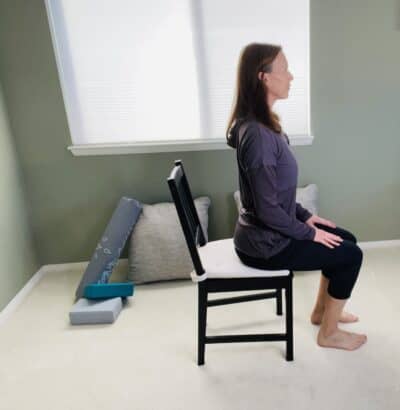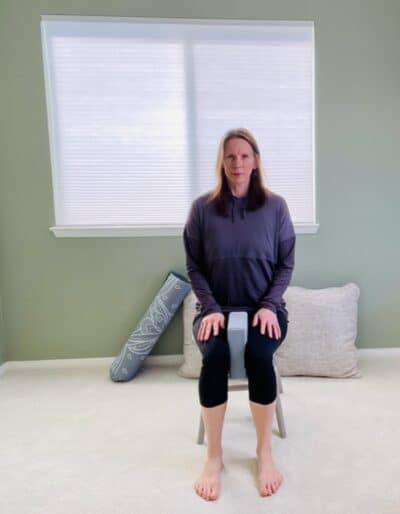Finding Your Core Power
If you have participated in any exercise programs, you may have heard the phrase “engage your core” or “contract your abdominals”. But what is the core, why is it important, and how do we do that? Using chair yoga to strengthen the core may be a great place to start. If you are looking for a chair yoga sequence, scroll to the bottom of the post for the video- chair yoga and the core. It is full of seated core exercises for seniors- or anyone really- that can be done right from the chair. Keep reading for how chair yoga can help strengthen the core and for two simple exercises to help you get started. If you would like some seated chair yoga videos, you can check out the links at the end for some chair yoga videos with a focus on the core.
This post contains affiliate links. I earn from qualifying purchases. This means that I may earn a commission should you choose to sign up for a program or make a purchase using my link. This is at no extra cost to you. I only recommend products that I truly believe are helpful. See our Privacy Policy and Disclosures page.
What Is The Core?
First of all, the core muscles include the erector spinae, rectus abdominis, obliques, transverse abdominis, and multifidus. It also includes the pelvic floor, the diaphragm, and the glutes. Last but not least, it includes the muscles that attach to the pelvis like the hamstrings, hip flexors, and adductors.
All that to say that it is not just your abdominal muscles, it includes your back and pelvis. It is the muscles in your trunk- front, back, sides. The muscles of the core help your trunk to stabilize so that you can move your limbs properly. Our functional movement is initiated from the core.
Why Is it Important?
First, we need these muscles in our low back, pelvis, hips, and abdomen to work together. They provide the stability we need to move our arms and legs. Secondly, they help us to achieve the balance we need to perform our functional tasks throughout the day. Finally, we need a strong and stable core to help protect the spine from heavy and repetitive forces.
We also need our core muscles to help us maintain good posture when we are not moving. Prolonged sitting with inadequate posture can result in pain throughout the body. It can start a cascade of issues that range from difficulty standing up from a chair, to issues with eating. This can be true for anyone- no matter what your physical ability is or what your fitness level may be.
You may have noticed that when you get tired and your back muscles are fatigued from prolonged activity or prolonged sitting, your shoulders don’t feel or work like you want them to. If we are rounded through the upper back or in a slouched posture, our shoulder joint can’t move through its available range of motion.
If we use our core muscles to maintain an upright and neutral spine, we can achieve much greater functional movement in our upper body. The same goes for our lower body. If we have difficulty standing upright, our steps will be shorter and less efficient when we are walking from place to place- and we will get tired quicker.
Adding in some simple seated core exercise for seniors throughout the day can really go a long way. Keep reading for some simple tips to get started, plus some printable resources, a video, and some more ideas for adding movement and exercise to our day.

Seated Core Exercises For Seniors: Chair Yoga and the Core
Take a quick moment to just check in with how you are seated in your chair right now- don’t change anything , just observe.
- How do you feel?
- Is there anything you can do to feel better?
- Have you been sitting too long?
- Is it time to get some movement?
- Is it time to change your position?
Practicing yoga can help us become more aware of our bodies. This is as true for when we are moving as it is when we are still. It takes a great deal of effort to sit with good posture unsupported for a prolonged amount of time. It takes much less effort from our bodies (and our brains) to sit in a slouched position. Yoga can be a tool for helping us be more mindful when it comes to our core and posture.
Take a simple exercise like raising your arms out in front of you to shoulder height:
- First, sit upright and bring awareness to your core.
- Ground down through both feet and feel what muscles contract.
- Then, raise your arms up and down slowly and mindfully a few times
Maintaining that good posture throughout the exercise will add a core component. You get two exercises for the price of one! There are countless ways and exercises to work the core. Giving some attention to our core muscles is crucial for our overall functional mobility and strength. The good news is that we can still work on our core muscles from the safety of our chair. Try the following exercises. Remember to never force or strain and only do what is right for you today:
Seated Back Bend/Cow Pose

- Begin seated in mountain pose with a long spine- feet are hip distance apart, parallel, and flat on the floor.
- Ground down through all 4 corners of your feet.
- Gently place your hands on the seat behind your hips- or you may choose to relax the hands by the sides or rest them on the thighs.
- Lengthen from the base of the spine to the crown (top) of the head.
- Release your shoulders back and down away from the ears.
- As you inhale, lift your chest toward the sky and gently squeeze your shoulder blades toward one another (gently arch the back)
- On an exhale return to your mountain pose/neutral spine. Repeat 2-3 times as desired.
- Notice how you feel- you may try to incorporate this stretch into your day.
Isometric Hip Adduction

- Hip Adduction Exercise
- Sit tall with an elongated spine and bring your knees together- feet are firmly planted on the floor.
- Place a yoga block, pillow, rolled towel, or a paper towel roll between the knees and gently press your knees together to engage your inner thighs.
- Hold for 5 counts and then relax the muscles completely- keep breathing evenly.
- Try to engage the core throughout by lengthening from the base of the spine to the crown of the head.
- Breath normally and do not hold your breath.
- Repeat 5-10 times as able.
Want More Resources For Seated Core Exercises For Seniors?
I invite you to check out this seated sequence with exercises for the core: Chair Yoga Sequence for the Core
Or this chair yoga sequence with poses for the core: Chair Yoga Poses To Engage The Core
This chair yoga sequence contains full body chair yoga poses that help us to engage the core: Full Body Chair Yoga For The Core
You may be interested in this free printable with 5 chair yoga poses: Chair Yoga For The Core
When practiced mindfully, this chair yoga pose helps to engage the whole body: Staff Pose
You can find more seated core exercises for seniors here: 5 For The Core
Check out this post if you are new to chair yoga: Is Chair Yoga Right For You?
You may also be interested in the 7 Day Chair Yoga Challenge , Day 4 is focused on the core.
You might be interested in reading this quick article to learn more about posture: Getting It Straight | NIH News in Health
Breathing and posture go hand in hand, take a look at Breathing For Better Mobility
This chair yoga sequence has a fun chair yoga version of a “headstand” that will help activate the core as well.
Finally, I invite you to sign up for the Monthly Email Newsletter to stay up to date on the latest blog posts and videos.
Namaste!
Disclaimer: The Peaceful Chair and thepeacefulchair.com strongly recommends that you consult with your physician before starting this or any exercise program.The information provided on this website is for informational purposes only and is not to be used in place of medical advice or information from your healthcare provider. Neither The Peaceful Chair, the peacefulchair.com, nor any of its contributors shall be held liable for any improper or incorrect use of the information described and/or contained herein and assumes no responsibility for anyone’s use of the information contained in any links, videos, or any content on this website.

Leave A Comment